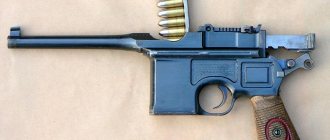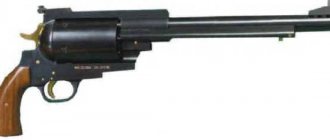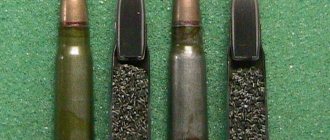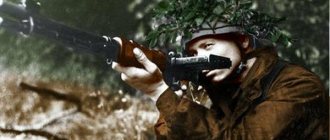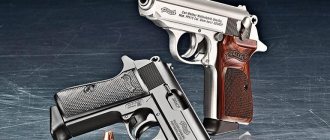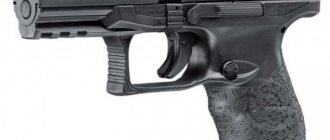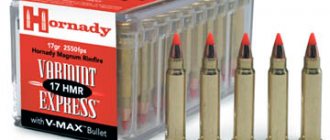Caliber history: 9x39 mm silent armor-piercing
The history of the creation of a special 9x39 mm cartridge and silent weapons for it
The creation of special silent weapons was carried out in many countries. In the USSR, long-term work led to the creation of a special 9x39 mm cartridge and weapons for it, as they say, “unparalleled.” Or is something wrong here again?
Back in the 30s, several types of domestic silencers for small arms were tested, the most famous of which was the “Bramith device” designed by Ivan Mitin, which was actively used during the Second World War.
The Bramit device and the Nagan revolver
After the war, work on creating special silent weapons continued. But still, “with all the wealth of choice,” the main silent weapon of army intelligence officers and other departments was a silencer (PBS) for a standard AKM paired with a subsonic US (Reduced Speed) cartridge.
The situation changed dramatically in the 70s. On the one hand, a new 5.45x39 mm cartridge was adopted for service with the army. The new cartridge had a number of advantages, but it was difficult to create a version for it with an effective subsonic bullet - although the corresponding work was also carried out. Another important factor was the new military requirements for promising silent systems - sniper and machine gun. Taking into account the development of personal protective equipment, the new special machine was required to hit a target wearing a 3rd class body armor at a distance of 400 meters. Since in any case we were talking about creating new rifle systems, since 1984, the work of ammunition specialists has focused on creating two types of subsonic cartridges - sniper and armor-piercing. The SP-5 sniper version was designed by N.V. Zabelin, L.S. Dvoryaninova, and the SP-6 increased penetration cartridge was designed by Yu.Z. Frolov and E.S. Kornilova. In the 90s, a cheaper version of the PAB-9 was added to them, and to the original VSS “Vintorez” and AS “VAL” - a whole series of small arms: 9A-91, VSK-94, OTs-14 “Groza”, SR -3 “Whirlwind” and others.
9x39 mm cartridges
It would seem that this is a “success story” in its purest form.
But although special silent systems have been actively and successfully used in a number of conflicts in recent decades, they have not yet been able to completely displace the same AKM with PBS and US. Previously, the reason cited was the relative rarity of special cartridges, which were a problem to “get” in the required quantities for fighters of not the most elite units, even if they had standard VSS/AS. But now there seems to be plenty of cartridges and the point, most likely, is that the fighters don’t really want to carry a second specialized barrel. Yes, the “US” plus “can” option works worse than a specialized product, but there are not so many combat situations when exactly all the advantages and advantages of the VSS/AS are needed. And when the shooting starts, the AS turns from a very special weapon into a rather mediocre machine gun. Therefore, explaining to subordinates both the advantages and limitations of available special weapons is one of the important tasks of the unit commander.
AKM with PBS
Somewhat similar processes are taking place on the other side of the Atlantic. For example, back in the Vietnam era, the United States created the Silent Sniper Rifle, a silent sniper rifle based on the Winchester Model 70 chambered for a specially designed heavy subsonic cartridge 458 x 1.5 Barnes. The rifle was successfully tested at the Aberdeen Proving Ground... and failed on the real battlefield, in Vietnam. Snipers in the war found these weapons too heavy and not accurate enough to solve sniper tasks at the distances they needed. The only thing they agreed on was that the rifle was really very quiet.
Of course, the Americans did not stop their research there - both the military and simply lovers of experimenting with ammunition. Over the years, they have developed many cartridge options with heavy subsonic bullets - . 458 SOCOM, .300 AAC Blackout and so on. We hope that their turn will come in our column, but for now we note that the “potential enemy”, as a rule, is not talking about new additional weapons, but about the modernization of standard M16/M4. Nevertheless, NATO does not show any particular haste in equipping its fighters with an analogue of VSS/Val, although individual purchases for the needs of special forces occur periodically.
Cartridges 9x39 mm
Finally, let us remember that not so long ago, “fenced” versions of the “screw cutter” and, accordingly, 9x39 mm sporting and hunting cartridges appeared on sale. True, if you do not take into account the desire to hang “an almost real screw cutter” on the wall, and not a barbarically cut-up model, the hunting prospects of weapons under 9x39 are quite doubtful. The silencer there serves a purely decorative function, and the 9x39 mm cartridge itself requires a fairly high level of skill from the shooter - in particular, quickly and accurately finding the distance to the target. Otherwise, instead of the beautiful antlers of an elk or deer, you may only get the tip of the tail as a trophy.
Modern Russian cinema about Russian special forces, where brave guys with silent sniper rifles and the same silent machine guns dashingly deal with “severely superior enemy forces”, creates a certain aura of coolness, invincibility and versatility around the recognizable (due to the integrated silencers) 9x39 mm weapons . It's not like that at all.
Weapons chambered for this cartridge are very highly specialized, and attempts to create mass-produced army weapons chambered for this cartridge have failed. As it was aptly said on one of the weapons forums: “The subject of discussion is a highly specialized mechanism for a very special application. Like nail scissors. It looks like scissors... But they’re very, damn special..."
There are quite a lot of weapons chambered for the “special silent” 9x39 mm cartridge.
Sniper rifle, special (VSS) “Vintorez”. Actually, the 9x39 mm cartridge was created for it. Year of adoption: 1987. Developed in Klimovsk, Moscow region. design team of the Central Research Institute of Precision Engineering under the leadership of Peter Serdyukov. “Works” at a range of up to 400 m against targets protected by body armor and up to 600 m against unprotected targets. For carrying, it is disassembled into several parts and packed into a special briefcase or a regular sports bag. It assembles and disassembles very quickly. The silencer is almost perfect, the parts of the rifle are fitted so that there are no additional sounds when reloading. A weapon for “working” in dense urban areas or in dense forest conditions, where distances are small, is close to ideal. I don’t know any complete foreign analogues. However, the thing is complex, low-tech and expensive.
“When used in combat, the VSS Vintorez sniper rifle turned out to be much more effective than all weapons of this purpose and class. The production of the VSS was established by the Tula Armory and was later adopted by the FSB, special forces of the Ministry of Internal Affairs and the Russian Armed Forces, as well as the presidential security service. In addition, the export of these weapons was established to the United States, as well as to the countries of South America and the Middle East. The design of the weapon was so successful that the AS Val and SR-3 Vikhr assault rifles were also developed on its basis. Wikipedia.
Special automatic machine (AS) “Val”. AS "Val" is a lightweight and simplified copy of the VSS "Vintorez", adapted for firing in automatic mode. The weapon was originally made with an integrated silencer. Due to its low weight, the machine turned out to be light and handy. The receiver is milled, so the “machine” is very strong and reliable. And in general, the weapon is made at the highest level: there is no play in the folding stock, as on serial Kalashnikov assault rifles, all gaps are made minimal, ergonomics are also excellent.
AS "Vikhr", another designation SR-3 "Vikhr" - a small-sized machine gun for special forces. The shortest weapon chambered for 9x39 mm. Designed to “work” over short distances, in dense urban areas. Shortened and lightweight design, no integrated muffler. Due to the low weight, heavy firing pin and rigid return spring, the barrel noticeably bounces during automatic shooting, which somewhat reduces shooting accuracy. The modernized version of the Vikhr assault rifle, SR-3M, involves the use of a silencer.
9A-91 assault rifle and VSK-94 sniper rifle. Developed in Tula. More technologically advanced and more... how can I say so without offending... clumsy, or something. There is no trace of the elegance of lines that distinguishes Klimov’s products. But they are cheap... Both the rifle and the machine gun use the same magazines as the VSS Vintorez and the Val and Vikhr machine guns.
Complex OTs-14 "Groza" made in Tula . An automatic weapon designed using a bullpup system with a huge number of different attachments.
All these weapons are very demanding to maintain. It is not intended for the average conscript soldier. However, the temptation to equip the army with such a silent superweapon was so great that for conscripts... the Kalashnikov assault rifle was created. AK-9 caliber 9x39 mm mod. 2003 produced by the Izhmash concern (now the Kalashnikov concern). An experimental batch of shortened Kalashnikov assault rifles (OTs-11 “Tiss”), the size of the well-known AKSU assault rifle, was developed at the Tula Central Design Bureau of Sports and Hunting Weapons (TsKIB SOO). But I did not find information about the production and use of these weapons, except for experimental exhibition batches, in open sources.
Foreign manufacturers could not ignore such a successful cartridge. The US Special Operations Command (USSOCOM), having tested the 9x39 mm ammunition itself, recommended the use of weapons chambered for this cartridge in American special operations. Today, at least one modification of an automatic rifle is known that uses Russian 9x39 mm cartridges: Colt LE 901-16S.
I did not find information about hunting weapons for civilian modification of the cartridge in open sources. Most likely, it just doesn't exist yet. The reasons here are more of a legal nature: in our country and most European countries, hunting with silencers is prohibited, and in the American market there is an abundance of their own weapons.
The “toy” version of the Vintorez airsoft rifle (Russian-made) is made from the same materials as military weapons. Completely corresponds in appearance, weight and weight distribution to military weapons. It costs, respectively, over 1000 US dollars.
The combat use of 9x39 mm weapons began during the war in Afghanistan. The weapon was then tested in the first and second Chechen campaigns. Here is a review from participants in those events. “The AC/VSS weapon system is close to the ideal weapon for special forces. Its skillful use can work wonders. So, for example, during one of the close fire battles, a reconnaissance group from our unit managed to kill five people, including the lead patrol, before the opposing side began to understand something.
The presence of standard day and night optics, an armor-piercing cartridge and an effective integrated silent and flameless firing device allows you to solve most of the problems that may arise before a special forces unit. For example, the classic problem of “taking down a sentry” is solved ideally by VSS (better than a thrown knife, crossbow...).” V. Holguin. "What we fought in Chechnya." Magazine "Soldier of Fortune", No. 8, 1997.
The “other side” also began to use such effective weapons. Thus, during the Beslan events, the militants who seized the school had at least one VSS rifle. The weapons were used by both sides during the Georgian-Ossetian conflict in 2008. It is believed that the VSS rifles and ammunition were transferred to the Georgian side by American military advisers.
Well, they're just killers. For contract killings, weapons of 9x39 mm caliber are ideal. It was developed for “this business”. The most famous case of use is the murder of the Minister of Internal Affairs of the Republic of Dagestan Adilgirey Magomedtagiro on June 5, 2009.
Prospects. Over almost three decades of combat use, the cartridge has found its tactical niche. Most likely, this cartridge will never be a mass-produced military ammunition, but will remain a specialized cartridge for special units conducting “delicate operations.”
PAB-9
During the development of a silent sniper system for special forces, TsNIITochmash designers had to deal with contradictory requirements. The use of ammunition with a subsonic bullet flight speed together with a silencer was supposed to ensure compliance with the requirements for noiselessness, since the sound from the ballistic wave was excluded, however, this contradicted the requirements for accuracy and penetrating ability, since as the bullet’s flight speed decreases, its damaging effect also decreases, as well as the flatness of the trajectory deteriorates. Initially, it was planned to use the 7.62 US cartridge in the complex (GRAU index - 57-N-231U), used in silent complexes based on the Kalashnikov assault rifle. As a result of calculations and experiments, it was found that, although it provides the required level of penetrating action and also meets the requirements for noiselessness, it is not suitable for use in a sniper complex due to low accuracy. Research was also conducted into the possibility of using the 7N1 sniper cartridge (7.62×54 mm R), which at that time had the best accuracy among domestic cartridges. During the research, a new cartridge was created, consisting of a 7N1 cartridge bullet and a 7.62x25 mm TT pistol cartridge case. It met the TTZ requirements for accuracy, but did not provide the required level of lethal effect (the shape of the bullet, intended for supersonic flight, affected it). The third option was to create a cartridge with the powder gases locked in the cartridge case. He did not go further than ballistic calculations due to the fact that in order to meet the requirements for accuracy/penetration power, the cartridge had to have a length of 85 mm and a mass of 50 g, which contradicted the requirements for compactness and lightness of the weapon.[3]
As a result, designer N.V. Zabelin and technologist L.S. Dvoryaninova, based on a 5.45×39 mm cartridge case, developed a 7.62 mm RG037 cartridge with a subsonic bullet flight speed, made according to the bullet pattern of the 7N1 cartridge, but modified from taking into account the requirements of external ballistics for bullets with subsonic flight speed. The total length of the cartridge was 46 mm, weight - 16 g, bullet weight - 10.6 g, median deviation (R50) at a distance of 100 m was 4 cm, and at a distance of 400 m - 16.5 cm [3]
The RG036 rifle chambered for this cartridge satisfied the requirements of the TTZ, however, due to the adoption of a more stringent TTZ in terms of armor penetration for a silent machine gun, the design team of the Central Research Institute Tochmash came to the conclusion that further work with the RG037 cartridge was inappropriate. In the mid-1980s, Zabelin and Dvoryaninova developed the 9-mm SP-5 sniper cartridge based on the 7.62×39 mm cartridge case, and designer Yu. Z. Frolov and technologist E. S. Kornilova developed the SP-6 cartridge with high penetration action.
VSS Vintorez rifle – video
The VSS Vintorez sniper rifle was developed by designers V.F. Krasnikov and P.I. Serdyukov at TsNIITochMash in the city of Klimovsk.
In 1987, the VSS Vintorez complex was adopted by reconnaissance and sabotage units of the USSR Armed Forces, internal troops of the Ministry of Internal Affairs and special forces units of the KGB of the USSR under the designation VSS (index 6P29).
VSS "Vintorez" sniper rifle - designed for silent and flameless sniper shooting at enemy personnel (defeating enemy reconnaissance groups, his command staff, sentries and observers), as well as disabling elements of military equipment, surveillance devices and unarmored enemy equipment at a distance up to 400m using an optical sight, and up to 300m using night sights.
The VSS rifle consists of:
– a barrel connected to the receiver – a butt – a bolt frame with a gas piston – a bolt – a return mechanism – a firing pin – a mainspring with a guide – a trigger mechanism – a receiver cover – a muffler housing, a separator and a forend.
The principle of operation of the automation and the purpose of the parts and mechanisms of the Vintorez rifle are based on the use of the energy of powder gases removed from the barrel bore into the gas chamber, and then converted into the kinetic energy of the moving automation system. Locking and unlocking the barrel bore is carried out by rotating the bolt around the longitudinal axis. The trigger mechanism is a striker type of original design, with the ability to conduct single and automatic fire. The cartridges are supplied from a double-row sector magazine with a staggered arrangement. The cartridge is chambered using the bolt. The spent cartridge case is removed by a spring-loaded swinging ejector mounted on the bolt. To reflect the spent cartridge case, a spring-loaded reflector located in the bolt is used.
The rifle barrel is only 200 mm long, chrome-plated, and has six right-hand rifling. On the hem of the barrel there are protrusions with bevels - for preliminary rotation of the bolt at the beginning of its locking. In the middle part of the barrel there is a gas chamber, as well as a cylindrical surface with annular grooves for attaching the muffler housing. In the muzzle there are 54 holes (6 rows of 9 holes), drilled along the rifling of the barrel. They are designed to discharge gases from the barrel bore into the expansion chamber of the muffler. A specially shaped separator spring is placed on the muzzle of the barrel. It ensures that the muffler is centered relative to the axis of the barrel bore. The muffler centering unit was created as an original design; its device is protected by a Russian patent.
The receiver serves to connect the parts and mechanisms of the rifle. It is made by milling from a steel billet. This significantly increases the rigidity of the structure, but at the same time increases the complexity of its manufacture and increases the cost. However, for special forces it is quite logical to have weapons that are more expensive, but provide high accuracy of fire and reliability. The top of the box is closed with a lid that protects the parts and mechanisms of the weapon from contamination. It is made of thin sheet steel by stamping. To give rigidity, with a small thickness of the metal, there are extrusions in it. On the right side of the cover there is a window for ejected cartridges and a cutout for moving the bolt handle.
The safety lock, which, when turned on, eliminates the possibility of turning the trigger, ensures the prevention of accidental shots due to falls, weapon impacts, or accidental pressing of the trigger. In the on position, the safety box closes the cutouts for moving the reloading handle and thereby protects the receiver from sand and dust getting into it. Protection against premature shots when the bolt is unlocked is provided by a self-timer, as well as by the relative position of the bolt frame and bolt when closing the barrel bore and locking the bolt.
On the left side of the receiver there are dovetail-type protrusions—mountings for optical sights. The central and two rear protrusions serve as a base for mounting night electro-optical sights, and the two front and central ones serve as a base for daytime optical sights.
The receiver also contains a fire type translator and a magazine latch with a spring.
The main rifle shooting mode is single. However, the design of the trigger mechanism, located in the receiver, provides for the possibility of automatic fire. The fire type translator is attached to the receiver inside the trigger guard, behind the trigger. To conduct single fire, the translator is placed in the “Single fire” position (indicated by one dot), and for automatic fire - “Automatic fire” (indicated by three dots). You can use the translator with the thumb and forefinger of the hand holding the handle.
To increase the accuracy of a sniper rifle, it is necessary that its mechanisms affect the weapon as little as possible during operation.
To fulfill this condition, the automatic rifle has light moving parts (bolt and bolt frame). Another solution was the use of six bolt lugs in the locking mechanism, interacting with the protrusions of the receiver. In this case, the two lower lugs act as a cartridge rammer. Locking and unlocking of the bolt is carried out by rotating it around the longitudinal axis, which occurs through the interaction of the tracking grooves of the bolt frame and the leading lugs of the bolt. This made it possible to ensure rigid symmetrical locking of the barrel and reduce energy losses when unlocking the bolt.
Another solution facilitating accurate shooting was the use of a striker-type impact mechanism. The light striker serves to break the igniter primer and, when de-cocked, gives the rifle a slight disturbing impulse. In addition, this design solution made it possible to facilitate the operation of the automation. This, as well as the specially designed layout of the gas outlet unit, ultimately made it possible to reduce the “tossing” of the weapon during a shot, which in turn made it easier to monitor the results of shooting through an optical sight.
The VSS strikers of the first series have a firing pin and a tail, in which there is a hole for the guide of the mainspring, grooves for guiding in the receiver, protrusions for cocking and for setting the striker on the self-timer. In subsequent releases, the firing pin was moved to the bolt. The cylindrical surface of the striker enters the bolt channel.
The return mechanism is designed to return the bolt frame with the bolt to the forward position after firing or loading the weapon, as well as to fix the receiver cover. The return spring guide together with the rod is a telescopic structure that provides the required stroke length of the bolt frame. To reduce noise when the moving system hits in the rear position, a polyurethane gasket is provided in the design of the return mechanism stop. To prevent the penetration of exhaust powder gases from the receiver to the shooter's face, there is a rubber sealing ring between the protrusion of the return mechanism stop and the receiver cover.
The mainspring serves to impart energy to the striker sufficient to break the cartridge primer. The mainspring guide also has a telescopic design.
The integrated silencer is an integral part of the rifle. It includes the muffler body and separator. The muffler body consists of an expansion chamber for preliminary release of gases and a muzzle muffler chamber. A separator is installed in the front part of the housing.
RVVDKU cadet with VSS at demonstration performances
The separator is a stamp-welded structure consisting of a bushing, insert, washer and cage. The cylindrical surface of the washer and bushing is used to ensure alignment of the separator and the body, the conical surface of the bushing is used to install the separator on the separator spring located on the muzzle of the barrel.
The silencer is put on the rifle barrel and secured to it with two cotters and a latch. This mount makes it easy to remove and install the silencer on the weapon. After the shot, when the bullet passes the front, perforated part of the barrel, part of the powder gases rushes through the side holes in the barrel into the expansion chamber of the muffler. In this case, the gas pressure in the barrel and their speed after the bullet leaves are reduced. A stream of powder gases flowing from the muzzle of the barrel hits the separator, which “divides” it into numerous multidirectional flows, intensively reducing their speed and temperature. As a result, the gases escaping from the silencer have a subsonic speed and low temperature, that is, they do not create pop or muzzle flash, and the sound level of the shot is approximately 130 dB, which corresponds to a small-caliber rifle.
The use of an integrated silencer made it possible to reduce (compared to a silencer mounted on the muzzle of the barrel) the overall length of the weapon.
The sight block with the aiming bar, the front sight base with the front sight, and the separator latch with a spring are attached to the muffler body.
The removable butt of a skeleton-type rifle (like the SVD) is made of multi-layer plywood. It is attached to the receiver using a dovetail lug and a latch. When creating the butt lock, an original design solution was used, protected by a Russian patent. The clamp ensures quick removal and attachment of the butt, and a rigid (without play) mount on the weapon.
The forend of the Vintorez rifle is made of plastic and is designed for ease of control of the weapon when shooting, protecting your hands from burns and securing the tube. The forend is held by the muffler body, and when the muffler is removed, by the body latch, which is automatically pressed during the assembly process by the internal inclined plane of the forend.
The trigger mechanism is used to release the firing pin from the combat cocking and from the self-timer cocking, to ensure single and automatic firing, to stop firing, to prevent shots when the bolt is unlocked and to put the machine on safety. The trigger mechanism is placed in the receiver and includes a safety, sear, disconnector, translator, self-timer, trigger, trigger spring, trigger axis, self-timer spring, sear spring and disconnector. The design of the trigger mechanism is also protected by a Russian patent.
For targeted shooting from a rifle and machine gun at various ranges, various day and night sights are used.
The daytime optical sight of the PSO-1-1 rifle is similar to the PSO-1 sight of the SVD sniper rifle, but with remote scales for the ballistics of the SP-5 cartridge. The upper handwheel of the sight - for setting the range - has a scale with numbers from 5 to 40, with a division value of 25 m, which corresponds to aiming angles for firing at ranges from 50 to 400 m. Since the ballistics of the SP-6 cartridge is close to the ballistics of the SP cartridge -5, the sight scale is used when firing both cartridges. The side handwheel, as in the PSO1 sight, is used to introduce lateral corrections. The sight reticle has one main square for aiming at the target. To the right and left of it is a scale of lateral corrections, below is a rangefinder scale for a target 1.7 m high (height figure) with numbers from 1 to 40 in tens of meters of range. The PSO-1-1 sight has 4x magnification and a field of view of 6°, its weight is 0.58 kg.
In addition to the PSO-1-1 sight, another daytime optical sight, the 1P43, can be used for firing from the VSS.
For shooting at night, the NSPU-3 or MBNP-1 night sight is used. Recently, a new generation of night sights has been created - the 1PN93 series of sights.
Fighter 45 OP Special Forces Airborne Forces with VSS
In case of failure of the daytime optical sight or the impossibility of its use for other reasons, a mechanical sighting device is used, consisting of a sector-type sight and a front sight in the front sight adjustable in height and in the lateral direction. The sight and front sight are located on the muffler body. The sighting bar has a mane with a slot for aiming and cutouts for holding the clamp in position. The sighting bar has a scale with divisions from 10 to 42: on the right side from 10 to 40, on the left - from 15 to 42. The scale numbers indicate firing ranges in tens of meters. This scale allows you to set the sight according to the distance to the target with an accuracy of up to 20 — 30 m.
On the base of the front sight and on the body there is a general mark that determines the position of the front sight after the weapon is brought into normal combat.
When using the weapon, placing the sight and front sight on the silencer requires strictly monitoring the correct connection of the silencer, protecting it from impacts and other mechanical damage.
One of the requirements for the new rifle when it was created. — possibility of concealed carrying and high readiness for combat use. Therefore, the rifle is disassembled into three main units - the rifle with the stock and silencer removed, the silencer and the stock. The time it takes to transfer it to a combat position is no more than 1 minute.
If necessary, the rifle can be transported disassembled into its main components in a 45x37x19 cm case or in a bag. To make the packaging in the case, a split wooden model of the rifle was created.
Ammunition VSS "VINTOREZ" SP-5, SP-6
Shooting from the VSS Vintorez rifle can be carried out:
– SP-5 (sniper) – SP-6 (increased armor penetration) cartridges.
These cartridges have the same charges, but differ in the design of the bullets.
The bullet of the SP-5 cartridge has a steel and lead core placed in a bimetallic shell. The shape of the bullet provides it with good ballistic properties when flying at subsonic speeds. The SP-5 cartridge does not have special markings; packaging cardboard boxes with such cartridges are labeled “Sniper”.
The bullet of the SP-6 cartridge consists of a hardened steel core of increased length, placed in a lead jacket and a bimetallic shell. The tip of the SP-6 cartridge bullet is painted black, and there is a black stripe on the box. The cartridge cases are steel, coated with green varnish.
Both cartridges have similar ballistics and can be used in both VSS and AC. At the same time, the SP-5 cartridge has better accuracy, and the SP-6 has armor penetration. The latter should be used to defeat personnel wearing personal protective equipment, as well as in cars or behind light shelters.
SP-5 and SP-6 cartridges are produced by the Klimovsky Stamping Plant.
In addition to standard ammunition, there are training cartridges SP-6UCH - for training in loading weapons. There are longitudinal grooves on its sleeve, and on the box there is the inscription “Training”.
To test the strength of the weapon locking unit, the SP-5UZ cartridge is used. On the packaging box with these cartridges there is the inscription “Enhanced charge”. They are used only in factory conditions; the use of such cartridges in the army is strictly prohibited.
Partial disassembly of VSS Vintorez
Silent weapons, when fired, become more contaminated with powder soot than conventional ones. Therefore, after firing the VSS, you need to clean it as quickly as possible. To do this, the rifle is partially disassembled, which is done without special tools.
The order of partial disassembly is as follows:
– Disconnect the magazine and check that there is no cartridge in the chamber. – Separate the muffler and disassemble it. – Remove the separator spring from the barrel. – Disconnect the rifle receiver cover. – Remove the return mechanism. 6. Remove the mainspring from the guide. – Take out the striker. – Separate the bolt carrier with the bolt and separate the bolt from the bolt frame. – Disconnect the handguard. – Separate the tube. – For VSS - separate the butt. – The weapon is assembled in the reverse order. It takes from 30 to 60 seconds.
VSS rifle configuration
Each VSS rifle is equipped with an individual set of spare parts ZIP-O.
It includes:
- ramrod; – affiliation; - oiler; – scraper; - knife; – five 10-round magazines; - belt.
The AS "Val" and VSS "Vintorez" magazines are interchangeable, so the rifle can be powered from both 10-round and 20-round (automatic) magazines. Oiler and accessories are from AKM. The scraper is used to remove carbon deposits from the walls of the bore. It screws onto the cleaning rod. The knife is designed to remove carbon deposits from the surfaces of the separator. Barrel and gas piston. It has two blades: one for cleaning the separator, the other for the outer surfaces, barrel and gas piston. Rifle stowage includes: a bag for carrying the rifle and a bag for carrying an optical sight, four magazines and spare parts.
